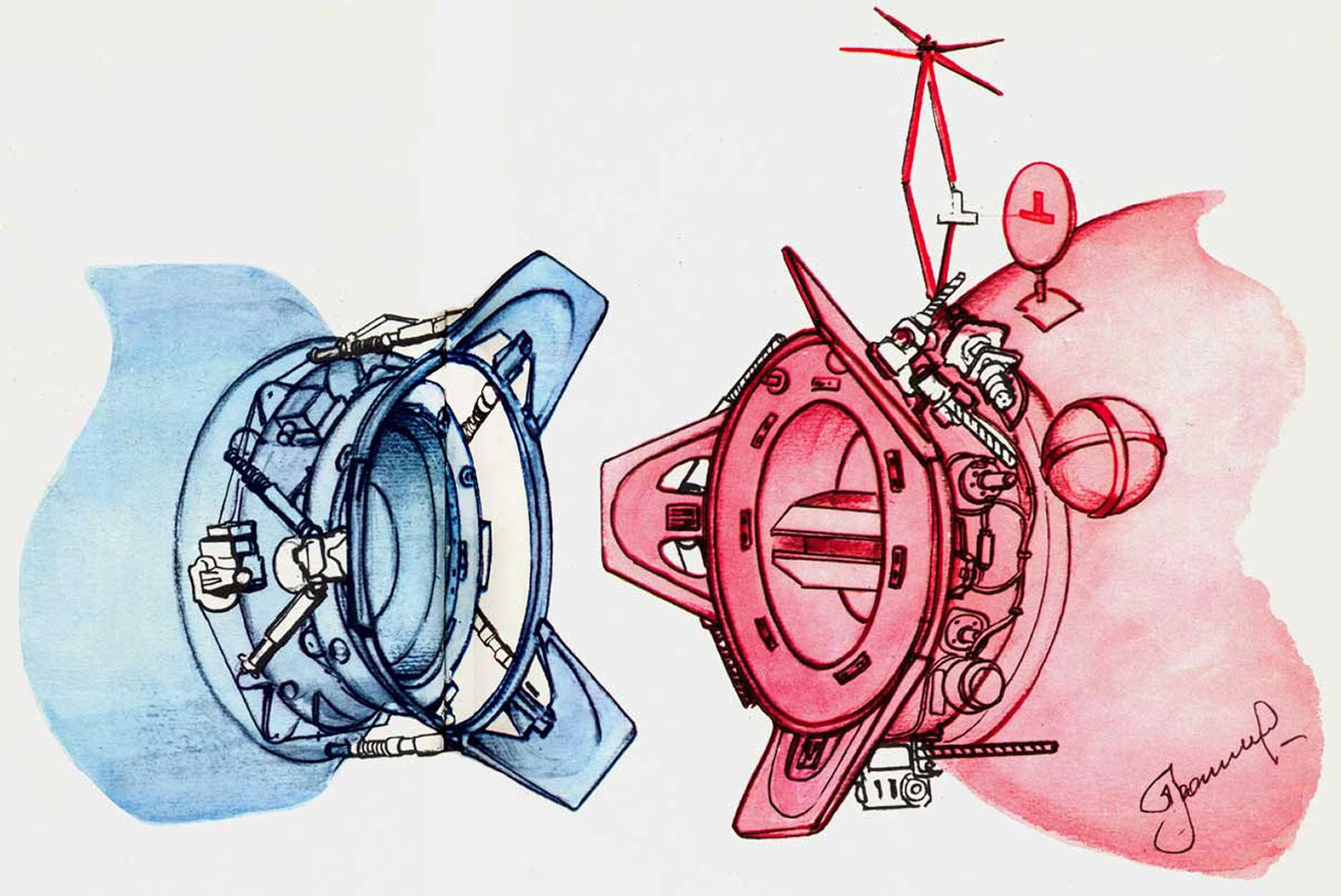“Soyuz” i “Apollon”: Rasskazyvaiut sovetskie uchenye, inzhenery i kosmonavty—uchastniki sovmestnyh rabot s amerikanskimi spetsialistami, ed. K. D. Bushuev (Izdatel’stvo politicheskoi literatury, 1976), 8.
“Soyuz” i “Apollon,” 123.
Soviet engineers made several curious remarks on the subject. “By the way, we’ve borrowed the term ‘androgynous’ from mythology: androgynes were hermaphroditic creatures,” confessed V. S. Syromiatnikov, the leader of the third ASTP work group. “Soyuz” i “Apollon,” 121.
The following passage is from the Gnostic Trimorphic Protennoia: “I am androgynous. I am Mother (and) I am Father, since I copulate with myself. I copulated with myself and with those who love me, and it is through me alone that the All stands firm. I am the Womb that gives shape to the All by giving birth to the Light that shines in splendor. I am the Aeon to come. I am the fulfillment of the All, that is, Meirothea, the glory of the Mother. I cast voiced Speech into the ears of those who know me.” See →.
See the first study of alchemy published in the Soviet Union: V. L. Rabinovich, Alhimiia kak fenomen srednevekovoi kul’tury (Nauka, 1979).
“Soyuz” i “Apollon,” 102.
One of the most difficult issues that American and Soviet engineers had to face was coordinating flight trajectories of the two ships to ensure their successful docking. Since space exploration programs in the Soviet Union and the US had been developing independently of each other, each country had a different model for calculating ballistics. The task of reconciling these models was extremely difficult. Later, engineer O. G. Sytin would write: “We managed to achieve practical compatibility of our ballistic calculations for a real flight. When everything was over, we would joke and say that we made everything possible and even made use of the ‘k-ballistics.’” “Soyuz” i “Apollon,” 96. It is hard to imagine anything more different than precise twentieth-century cosmic science and esoteric teachings. At the same time, these systems are polar opposites to such an extent that at some points they begin to collapse into each other.
Quoted in Rabinovich, Alhimiia, 98.
“I brought several vodka labels from earth—Stolichnaya and Osobaya—and attached them to the food tubes. Once we were all seated around the table I handed everyone their tube. ‘Come on, guys,’ I said. ’We can’t.’ ’It’s a Russian tradition. Before we eat, we must drink Russian vodka. It’s very good for your stomach.’ They stopped protesting. We opened the tubes and cheered. We have photos of Deke Slayton looking bewildered, having just discovered that it was borscht and not vodka after all. That was a simple human joke.” See →.
Rabinovich, Alhimiia, especially the chapter “Alhimicheskii retsept: deistvie i sviashennodeistvie.”
In another interview, Leonov spoke of an instance of improvisation during the flight: “During one of the discussions of the Apollo-Soyuz flight, there was an argument about what minimal distance should be maintained between the two ships, before the mutual maneuvers could begin. Until the very last moment, NASA bureaucrats kept on insisting that the distance between our ships could not be less than 150 meters. However, Tom Stafford, Apollo’s captain, disagreed and insisted that forty-five meters would suffice. At that moment, I pulled Stafford out of the room and told him: ‘They won’t be there to control us once we are out in space. Let’s just act as we see fit and not tell them about it.’” See →.
Rabinovich, Alhimiia, 59.
See →.
Rabinovich, Alhimiia, 79.
Rabinovich, Alhimiia, 79.
For more on the experiments conducted during the Soyuz-Apollo flight, see NASA’s Apollo-Soyuz Mission documentary film (1975) →.
Engineeer V. A. Ol’shevskii noted that “most of the microbes (they) found were on the surface of the docking tunnel and in the parts of the ship closest to the docking apparatus.” “Soyuz” i “Apollon,” 191.
“Soyuz” i “Apollon,” 112.
Besides, “alchemical gold and silver form a pair, yet they are hardly opposites. They represent the gradations of perfection.” Rabinovich, Alhimiia, 108. Gold and silver, sun and moon can trade places as easily as any of the components of the alchemical pairs.
“Matter, once it is animated by fire, begins to darken. Black contains white, yellow, and red colors. White for alchemists did not signify higher purity—it was simply one color among many. Black, on the other hand, was believed to be as a source of all other colors.” Rabinovich, Alhimiia, 93.
Peter Sloterdijk. Foams: Spheres, Volume III (Nauka, 2010), 313.
See →.
Elaine Pagels writes: “Valentinus and his followers … argued that only one’s own experience offers the ultimate criterion of truth, taking precedence over all secondhand testimony and all tradition—even gnostic tradition! They celebrated every form of creative invention as evidence that a person has become spiritually alive. On this theory, the structure of authority can never be fixed into an institutional framework: it must remain spontaneous, charismatic, and open.” Pagels, The Gnostic Gospels (Vintage Books, 1989), 25.
For instance, consider the following lines from the Gnostic Gospel of Philip: “And the companion of … Mary Magdalene … loved her more than all the disciples, and used to kiss her often on her mouth. The rest of the disciples … said to him, ‘Why do you love her more than all of us?’ The Savior answered and said to them, ‘Why do I not love you like her? When a blind man and one who sees are both together in darkness, they are no different from one another. When the light comes, then he who sees will see the light, and he who is blind will remain in darkness.’” See →.
Tertullian, De cultu feminarum, ca. 190–220AD.
See →.
Rabinovich, Alhimiia, 85.
Translated from the Russian by Anastasiya Ospiova.
